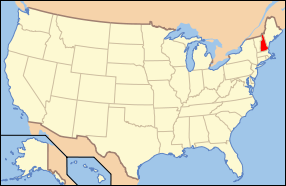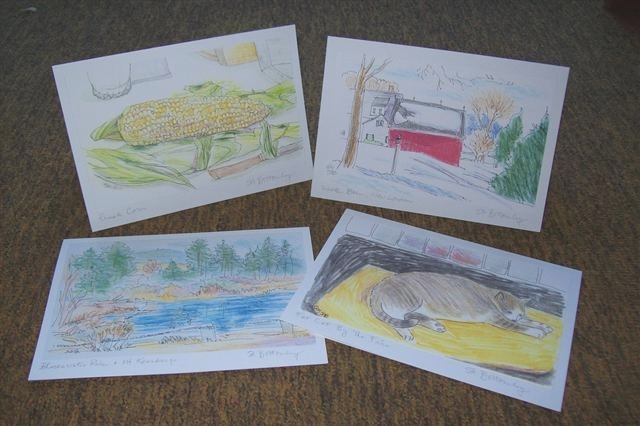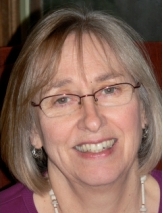 This is the central market in Dijon, France, drawn in December 1966. I lived in Dijon for two college semesters when I was twenty years old. From September to June. I took classes at the L'Université de Dijon and earned credits through the University of New Hampshire in Durham. It was the second year of the program and nine of us went. It was one of the most memorable years of my life. I was very pleased to recently find my sketchbooks from that year.
This is the central market in Dijon, France, drawn in December 1966. I lived in Dijon for two college semesters when I was twenty years old. From September to June. I took classes at the L'Université de Dijon and earned credits through the University of New Hampshire in Durham. It was the second year of the program and nine of us went. It was one of the most memorable years of my life. I was very pleased to recently find my sketchbooks from that year.When I was growing up in New England, we bought our food and necessities in a small store or shop. If it was slightly larger, we called it a supermarket. Although some of my family members had gardens and swapped produce around, I had never been to a farmer’s market.
I remember now that I was especially attracted to the bright colors of Dijon’s open air market during the dark season of the year. Every Saturday I walked there, and then wandered in blissful stupification. Open barrels of spices, leading to hand printed kitchen textiles, on to cheap house slippers, then rows of hanging skinned rabbits with just enough fur left for clear identity. The sellers above are hawking piles of fabric and selections of warm coats.
My room was cold. I bought tea, coffee, pastries, cookies, and cheese. I gained twenty pounds. I lost it when the weather warmed up.
I remember now that I was especially attracted to the bright colors of Dijon’s open air market during the dark season of the year. Every Saturday I walked there, and then wandered in blissful stupification. Open barrels of spices, leading to hand printed kitchen textiles, on to cheap house slippers, then rows of hanging skinned rabbits with just enough fur left for clear identity. The sellers above are hawking piles of fabric and selections of warm coats.
My room was cold. I bought tea, coffee, pastries, cookies, and cheese. I gained twenty pounds. I lost it when the weather warmed up.
 In another part of the market are the fruit stalls. Notice the clothing details I carefully included. People are dressed warmly, but formally. Long coats, fur collars, berets, stockings and heels. In the background I drew the ironwork roofs of the Victorian-era covered market.
In another part of the market are the fruit stalls. Notice the clothing details I carefully included. People are dressed warmly, but formally. Long coats, fur collars, berets, stockings and heels. In the background I drew the ironwork roofs of the Victorian-era covered market.This market was quite a walk from my room, and I learned almost immediately not to buy more than I could carry for long distances. I came here for the visual and sensory effects, and bought most items closer to my part of town.
I usually ate in the dining hall, as I didn’t really have kitchen privileges.
 Here is the a small view of the large indoor market. I love the madames in their stockings and heels and rainhats, and the fleuriste in her rubber boots. I can remember my pleasure in drawing the flowers, the cheeses, not to mention the rows of sausages.
Here is the a small view of the large indoor market. I love the madames in their stockings and heels and rainhats, and the fleuriste in her rubber boots. I can remember my pleasure in drawing the flowers, the cheeses, not to mention the rows of sausages.These are a kind of dry sausages called saucissons that don’t need refrigeration. Most are very garlicky and delicious. People buy them to eat on the trains for long journeys. I ate my first one on a train when my compartment seatmates offered me a slice. I was hungry, and thankful.
 I have a special fascination with turrets. This one, of cream colored stone, is on a corner behind the Palais Des Ducs, or the Dukes’ Palace. It was built as a private residence, and still is I think. It is on Rue Vannerie, a medieval street in the heart of Dijon.
I have a special fascination with turrets. This one, of cream colored stone, is on a corner behind the Palais Des Ducs, or the Dukes’ Palace. It was built as a private residence, and still is I think. It is on Rue Vannerie, a medieval street in the heart of Dijon.Dijon is a beautiful city, the capital of Burgundy. The powerful dukes’ lands once included parts of Holland. The dukes were very wealthy. And it shows. Absolutely nothing reminded me of New Hampshire.
This is why I went away from home for a year. It was a year of challenge, awe, growth, mortification (grammatical errors and incorrect vocabulary), daily confusion, and a growing love of travel, history, culture, food, architecture and people. In no particular order.
 A turreted rowhouse in Highlandtown, a part of Baltimore. Eastern Avenue. This is a modest sized brick rowhouse. I think the builder (about 1900) added the ambitious flourish of the turret because the street borders Patterson Park. There is always prestige to facing open land.
A turreted rowhouse in Highlandtown, a part of Baltimore. Eastern Avenue. This is a modest sized brick rowhouse. I think the builder (about 1900) added the ambitious flourish of the turret because the street borders Patterson Park. There is always prestige to facing open land.Every corner house on this street once had such a structure. This is the only one left intact. The rest have lost their hats or roof peaks, and are now flat across the top. Even though I think it misses the mark architecturally, I still like it. It is exuberant.
The two street flags are attempts to entice shoppers to buy locally, rather than head for the large malls, or Ikea. The sign that says ‘Patterson’ was once a theater and is now an art center.
 We searched out the Peabody-Essex Museum in Salem, Massachusetts to take in an exhibit about China.
We searched out the Peabody-Essex Museum in Salem, Massachusetts to take in an exhibit about China.But this is the room I decided to draw. It is a fascinating mixture of folk art, fine art, craft and painted furniture. Everything in this room had either a neck, feet, or both. It challenged me to figure out why each item was included in the eclectic groupings.
The large pot closest to the eye was done in 2000 I believe. The hanging chicken sign, the paintings and the furniture done in the 1800’s. The treasures were displayed on glass shelving. This is why the silver tea and coffee pot set appears to be walking through space.
The paintings of trained and self taught artists hung side by side. I have never seen this before and it was visually stimulating. I would like to go back to this room. It was a fun house.
The paintings of trained and self taught artists hung side by side. I have never seen this before and it was visually stimulating. I would like to go back to this room. It was a fun house.

I had in mind to go to the Baltimore Museum of Art to see some American porcelain. Well, that room was closed for the day, so I made do with a room full of British lusterware pottery.
As in the last museum, the shelves here are glass. I love this effect of floating objects meshing visually with items in the distance. In the background is an ornately carved chair.
Interestingly, these pitchers (or jugs) have references to the new country of the United States of America. The one with the eagle commemorates the presidency of Thomas Jefferson. The small one at the bottom with the copper luster glaze has a poem on the back about the need for the emancipation of slaves.
So, in the 1800’s, your dinnerware could serve up your political and social beliefs at the same time as your party food.
As in the last museum, the shelves here are glass. I love this effect of floating objects meshing visually with items in the distance. In the background is an ornately carved chair.
Interestingly, these pitchers (or jugs) have references to the new country of the United States of America. The one with the eagle commemorates the presidency of Thomas Jefferson. The small one at the bottom with the copper luster glaze has a poem on the back about the need for the emancipation of slaves.
So, in the 1800’s, your dinnerware could serve up your political and social beliefs at the same time as your party food.
 The Patterson Park Charter School on Baltimore Street in Baltimore, Maryland. The grey building to the left is the massive stone structure of St. Elizabeth of Hungary Church. To the far right are the small brick rowhouses of Belnord Street. I am struck by the strange disharmony of all the differing building styles. On some level, it is this disharmony which makes city life seem interesting and vital.
The Patterson Park Charter School on Baltimore Street in Baltimore, Maryland. The grey building to the left is the massive stone structure of St. Elizabeth of Hungary Church. To the far right are the small brick rowhouses of Belnord Street. I am struck by the strange disharmony of all the differing building styles. On some level, it is this disharmony which makes city life seem interesting and vital.For many years, we lived not in Baltimore, but in a nearby planned city of Columbia. It was socially innovative, but an architectural snooze.
The school is being expanded which explains the yellow fences and general disorder on the right side of the brick building. I participate in an art fundraiser there each spring.
The cars are drawn even funnier than usual because my hands were so cold.
 My artist friend Mary Jo Tydlacka is drawing in her studio in Maryland. I somehow forgot to draw her chair. But the form of her jacket (red with blue lining) draped over it indicates exactly where it is.
My artist friend Mary Jo Tydlacka is drawing in her studio in Maryland. I somehow forgot to draw her chair. But the form of her jacket (red with blue lining) draped over it indicates exactly where it is.She is known for her paintings of outdoor Shakespeare performances, and her images of Ellicott City.
 Our daughter Karin is cutting out pattern pieces for a Christmas gift that she will sew. Her iron is on the side of the table ready to press the seams open. The green squares is a cutting board.
Our daughter Karin is cutting out pattern pieces for a Christmas gift that she will sew. Her iron is on the side of the table ready to press the seams open. The green squares is a cutting board.I drew her in a sort of see-through version. She is bending forward to pin the heart fabric. You see her back and her pony tail heading straight up. Their living room, with the windows and door, is down some stairs and in the far distance.
I like this drawing. That I have to do this much explaining may mean the composition is not too successful. We could set up a discussion group. Maybe Facebook..., never mind, just kidding.
 Lucy, our grand-cat, lives in Baltimore. Here she is in a Zen moment. Sitting in the sunshine, on a yellow pillow, on a blindingly bright orange chair. She is either staring at the back of the chair in a om moment, or shutting her eyes centering herself.
Lucy, our grand-cat, lives in Baltimore. Here she is in a Zen moment. Sitting in the sunshine, on a yellow pillow, on a blindingly bright orange chair. She is either staring at the back of the chair in a om moment, or shutting her eyes centering herself.I couldn’t check on this. I had to grab my pencils and draw away. As soon as I finished, she jumped down.





Sue, I love seeing your memories from college days in the French pictures. How lucky is that that you kept those great pictures.
ReplyDeleteSarah T.
Hi Sue Anne,
ReplyDeleteI, too, enjoyed the French pictures. I spent a college summer in the 60's in France but have only mental pictures to remind me of the differences that I experienced there. Such a gift!